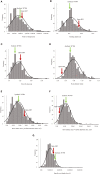Chromosome groups 5, 6 and 7 harbor major quantitative trait loci controlling root traits in bread wheat (Triticum aestivum L.)
- PMID: 37021301
- PMCID: PMC10067626
- DOI: 10.3389/fpls.2023.1092992
Chromosome groups 5, 6 and 7 harbor major quantitative trait loci controlling root traits in bread wheat (Triticum aestivum L.)
Abstract
Identifying genomic regions for root traits in bread wheat can help breeders develop climate-resilient and high-yielding wheat varieties with desirable root traits. This study used the recombinant inbred line (RIL) population of Synthetic W7984 × Opata M85 to identify quantitative trait loci (QTL) for different root traits such as rooting depth (RD), root dry mass (RM), total root length (RL), root diameter (Rdia) and root surface areas (RSA1 for coarse roots and RSA2 for fine roots) under controlled conditions in a semi-hydroponic system. We detected 14 QTL for eight root traits on nine wheat chromosomes; we discovered three QTL each for RD and RSA1, two QTL each for RM and RSA2, and one QTL each for RL, Rdia, specific root length and nodal root number per plant. The detected QTL were concentrated on chromosome groups 5, 6 and 7. The QTL for shallow RD (Q.rd.uwa.7BL: Xbarc50) and high RM (Q.rm.uwa.6AS: Xgwm334) were validated in two independent F2 populations of Synthetic W7984 × Chara and Opata M85 × Cascade, respectively. Genotypes containing negative alleles for Q.rd.uwa.7BL had 52% shallower RD than other Synthetic W7984 × Chara population lines. Genotypes with the positive alleles for Q.rm.uwa.6AS had 31.58% higher RM than other Opata M85 × Cascade population lines. Further, we identified 21 putative candidate genes for RD (Q.rd.uwa.7BL) and 13 for RM (Q.rm.uwa.6AS); TraesCS6A01G020400, TraesCS6A01G024400 and TraesCS6A01G021000 identified from Q.rm.uwa.6AS, and TraesCS7B01G404000, TraesCS7B01G254900 and TraesCS7B01G446200 identified from Q.rd.uwa.7BL encoded important proteins for root traits. We found germin-like protein encoding genes in both Q.rd.uwa.7BL and Q.rm.uwa.6AS regions. These genes may play an important role in RM and RD improvement. The identified QTL, especially the validated QTL and putative candidate genes are valuable genetic resources for future root trait improvement in wheat.
Keywords: QTL; candidate genes; genomic region; markers; phenotyping; recombinant inbred lines.
Copyright © 2023 Halder, Liu, Chen, Yan and Siddique.
Conflict of interest statement
The authors declare that the research was conducted in the absence of any commercial or financial relationships that could be construed as a potential conflict of interest.
Figures



Similar articles
-
Identification and validation of a major chromosome region for high grain number per spike under meiotic stage water stress in wheat (Triticum aestivum L.).PLoS One. 2018 Mar 8;13(3):e0194075. doi: 10.1371/journal.pone.0194075. eCollection 2018. PLoS One. 2018. PMID: 29518125 Free PMC article.
-
Identification and Validation of a Chromosome 4D Quantitative Trait Locus Hotspot Conferring Heat Tolerance in Common Wheat (Triticum aestivum L.).Plants (Basel). 2022 Mar 9;11(6):729. doi: 10.3390/plants11060729. Plants (Basel). 2022. PMID: 35336611 Free PMC article.
-
Identification and validation of QTL and their associated genes for pre-emergent metribuzin tolerance in hexaploid wheat (Triticum aestivum L.).BMC Genet. 2018 Nov 12;19(1):102. doi: 10.1186/s12863-018-0690-z. BMC Genet. 2018. PMID: 30419811 Free PMC article.
-
Protein biomarkers for root length and root dry mass on chromosomes 4A and 7A in wheat.J Proteomics. 2024 Jan 16;291:105044. doi: 10.1016/j.jprot.2023.105044. Epub 2023 Nov 4. J Proteomics. 2024. PMID: 37931703
-
Regulation of root growth and elongation in wheat.Front Plant Sci. 2024 May 21;15:1397337. doi: 10.3389/fpls.2024.1397337. eCollection 2024. Front Plant Sci. 2024. PMID: 38835859 Free PMC article. Review.
References
-
- Acuna T. B., Rebetzke G., He X., Maynol E., Wade L. (2014). Mapping quantitative trait loci associated with root penetration ability of wheat in contrasting environments. Mol. Breed. 34 (2), 631–642. doi: 10.1007/s11032-014-0063-x - DOI
-
- Alexandratos N., Bruinsma J. (2012). World agriculture towards 2030/2050: The 2012 revision. Rome, FAO.
LinkOut - more resources
Full Text Sources
Miscellaneous

